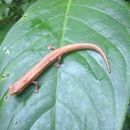en
names in breadcrumbs


Bolitoglossa insularis is a species of salamander in the family Plethodontidae. It is endemic to Nicaragua. Its habitat includes premontane moist forests.
Bolitoglossa insularis is a species of salamander in the family Plethodontidae. It is endemic to Nicaragua. Its habitat includes premontane moist forests.
Bolitoglossa insularis es una especie de salamandras en la familia Plethodontidae.[2]
Es endémica de la isla Ometepe, en el lago Cocibolca (Nicaragua).[2]
Se encuentra ligeramente amenazada por la pérdida de su hábitat natural.
Bolitoglossa insularis es una especie de salamandras en la familia Plethodontidae.
Es endémica de la isla Ometepe, en el lago Cocibolca (Nicaragua).
Bolitoglossa insularis Bolitoglossa generoko animalia da. Anfibioen barruko Plethodontidae familian sailkatuta dago, Caudata ordenan.
Bolitoglossa insularis Bolitoglossa generoko animalia da. Anfibioen barruko Plethodontidae familian sailkatuta dago, Caudata ordenan.
Bolitoglossa insularis est une espèce d'urodèles de la famille des Plethodontidae[1].
Cette espèce est endémique du département du Río San Juan au Nicaragua. Elle se rencontre dans l'île d'Ometepe dans le lac Nicaragua à environ 800 m d'altitude[1].
La femelle holotype mesure 120,6 mm dont 55,9 mm pour la queue[2].
Son nom d'espèce, du latin insularis, « insulaire », lui a été donné en référence à son aire de répartition supposée restreinte à l'île d'Ometepe.
Bolitoglossa insularis est une espèce d'urodèles de la famille des Plethodontidae.
Bolitoglossa insularis é uma espécie de anfíbio caudado da família Plethodontidae.[2][3] Está presente na Nicarágua.[3] A UICN classificou-a como vulnerável.[4]
Bolitoglossa insularis é uma espécie de anfíbio caudado da família Plethodontidae. Está presente na Nicarágua. A UICN classificou-a como vulnerável.